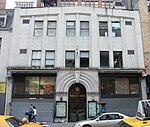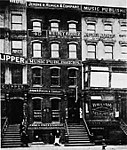Fifth Avenue Theatre

Fifth Avenue Theatre was a Broadway theatre in New York City in the United States located at 31 West 28th Street and Broadway (1185 Broadway). It was demolished in 1939. Built in 1868, it was managed by Augustin Daly in the mid-1870s. In 1877, it became the first air-conditioned theatre in the world. In 1879, it presented the world premiere of The Pirates of Penzance by Gilbert and Sullivan and the New York premiere of H.M.S. Pinafore, followed by other Gilbert and Sullivan operas throughout the 1880s. The theatre continued to present both plays and musicals through the end of the century. At the beginning of the 20th century, the theatre presented English classics and then vaudeville, and later films, as well as plays and musicals.
Excerpt from the Wikipedia article Fifth Avenue Theatre (License: CC BY-SA 3.0, Authors, Images).Fifth Avenue Theatre
West 28th Street, New York Manhattan
Geographical coordinates (GPS) Address Nearby Places Show on map
Geographical coordinates (GPS)
| Latitude | Longitude |
|---|---|
| N 40.7454 ° | E -73.9894 ° |
Address
West 28th Street 32
10001 New York, Manhattan
New York, United States
Open on Google Maps







